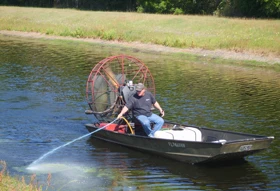
.jpg) Much like landscaping, aquatic weed control requires knowledge about plant types, weed removal technique and important licensure issues.
Much like landscaping, aquatic weed control requires knowledge about plant types, weed removal technique and important licensure issues.
But the fact that aquatic weed removal is being done underwater adds a different layer of challenges.
There are a variety of ways that aquatic plant life can be removed from a body of water, whether it’s a lake, retention pond, golf course water hazard, residential pond or another body of water. Chemicals, biological methods (such as using fish), mechanical methods (such as using harvester equipment or screens) and hand removal (which can require scuba diving equipment), are the primary ways that aquatic weed control companies manage underwater plant life. Many aquatic control companies are specialized and focus either on large bodies of water like lakes, while others focus primarily on residential communities doing work for homeowners’ associations on stormwater retention ponds or individual backyard ponds. Golf courses are also a prime target for the aquatic weed control market.
Tom Hill, president of Aquatic Weed Control in the Seattle region, has an extremely focused niche. Using a specially created aqua screen, his company aims to clear the weeds from the area of a lake near the dock so that people can swim or get their boats started.
“It’s such a narrow specialty that we focus on,” says Hill, who says the company is almost like a “side business” for him. “We focus on homeowners of lakefront properties who want a few thousand square feet of weed-free space to swim or start their boats. We are very busy two or three months out of the year, and then I put my energy back into my specialty cleaning business.”
In tropical climates, however, many businesses keep busy year round. “Like landscaping, there are seasonal fluctuations as we certainly use more chemical in the summer,” says Eric Inman, president, Aquatic Weed Control in Orlando, Fla. “But just like landscapers are always looking for enhancement work, we find add-ons that help sustain business. We get requests to physically remove vegetation or add a fountain. Those types of jobs become add-on services.”
|
Must-Have Equipment While there are different methods for aquatic weed management and removal, the following three pieces of equipment are key for launching an aquatic weed control service. Boat. If you’re dealing with large bodies of water, a boat with a self-contained spray tank – anywhere between 50 and 100 gallons – is a necessity for navigating the waters. Companies that work in locales like the Florida Everglades even invest in air boats. ATV. You’ll need some type of an all-terrain vehicle to spray the shorelines of any body of water you’re working on. Make sure your ATV has plenty of room for a self-contained spray tank in the back. Backpack Sprayer. A backpack sprayer will allow you to handle weed control on foot, getting into those areas you can’t get to with a larger vehicle and targeting specific plants. |
Working with landscapers. While these companies are often working on the same properties as landscapers, the two industries have remained quite separate.“We have seen some landscape companies and pest control companies that have gotten into this business but there are deterrents that have kept many from jumping in,” says Inman. “In dealing with bodies of water, there is a lot of regulation. States also have different requirements for commercial aquatic applicator’s licensing.”
Jim Donahoe, owner of Indiana-based Aquatic Weed Control, adds, “Regulation is really the biggest challenge as some states will require you to get a permit just to treat a private pond,” he says. “You also need to be licensed in aquatics in your state and make sure you file National Pollution Discharge permits. The penalties for not doing so are steep.”
Controlling the plants can also get very technical. “When you have pickerelweed, which can be beneficial to the pond, intertwined with cattail, which you want to remove, you need to be careful that you don’t kill both,” says PJ Myers, general manager, Applied Aquatic Management in Florida. “It can become technical to try and select certain plants you want to maintain while getting rid of those that cause problems.”
But perhaps a key reason why many landscapers don’t get into the specialty of aquatic weed control is because of the catch-22 it creates. In many cases, the overgrowth of aquatic plant life like algae is caused by landscapers.
Charles has a hope for the future of property management in which landscapers and aquatic weed control experts can work together through the guidance of a property manager who knows all of the chemicals being used both to treat aquatic growth and those being used as fertilizers.
“Because landscaping is so competitive in this region, there’s a lot of secrecy and a landscaper might not be willing to share what chemicals they’re using on the lawn so that their competition doesn’t find out,” says Charles. “But for those of us dealing with aquatic weed control, that information is really important.”
The author is a frequent contributor to Lawn & Landscape.

Explore the April 2012 Issue
Check out more from this issue and find your next story to read.
Latest from Lawn & Landscape
- ExperiGreen, Turf Masters Brands merge
- EquipmentShare cuts ribbon on new Maryland branch
- Strathmore acquires Royal Tree Service in Montreal
- In a new direction
- The December issue is now live
- Ignite Attachments debuts 80-inch, severe-duty bucket
- EquipmentShare breaks ground on Roswell branch
- NaturaLawn of America adds Schwartz, Medd to operations team





